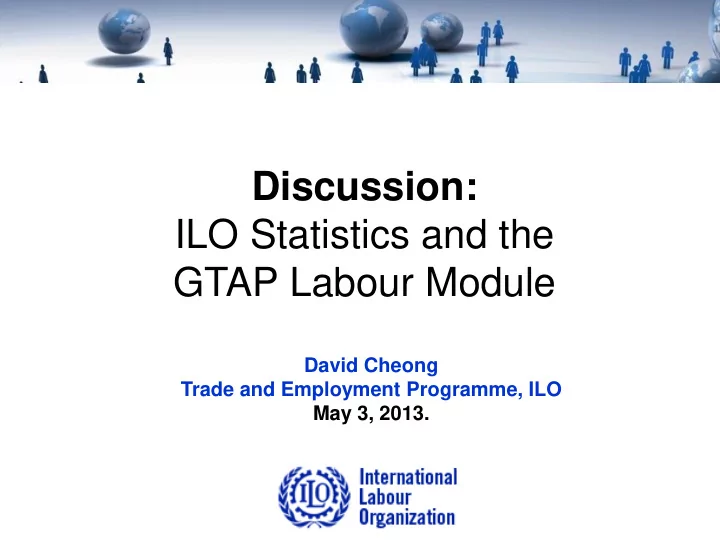

Discussion: ILO Statistics and the GTAP Labour Module David Cheong Trade and Employment Programme, ILO May 3, 2013.
CGE Assessments, Trade, and Labour • CGE-type impact assessments are becoming a regular part of the official process of trade- agreement negotiations. • Most CGE assessments of trade policy focus on the economic impacts but not the social . • The number of trade agreements with labour provisions was 4 in 1995 but 50 in 2012 , of the 230 trade agreements listed in the WTO’s Regional Trade Agreements Database.
Labour in CGE Models “If we look at the body of CGE literature as a whole, the labour market has certainly not been one of the main points of attention . In fact, many of the classical CGE studies in the areas of trade liberalisation, tax analysis and climate policy work with the simplest possible set of assumptions about the labour market: labour supply is fixed and a uniform, flexible, market-clearing wage balances labour supply and demand ” . S. Boeters and L. Savard, The Labour Market in CGE Models, Chapter 26 in P. Dixon and D. Jorgenson (eds.), Handbook of CGE Modeling, (2012)
Typical Labour Assumptions in CGE Models Fixed labour supply no changes in labour force participation or composition (e.g., unskilled worker cannot become skilled worker and vice versa). Uniform wage ignores wage dispersion and differences in wage dynamics across worker groups. Flexible wage ignores existence of institutions (e.g., indexation, statutory limits, wage-setting mechanisms) and fact that wage changes are infrequent. Market-clearing wage ignores UNEMPLOYMENT! Perfect inter-sectoral mobility ignores physical, skill, legal, and cultural barriers.
Wage Results from “ Enriching U.S. labor results in a multi-regional CGE model”: Global Liberalization Scenario ( B Simulations ) Standard GTAP Framework, 22 Occupations: ( C Simulations ) Revised GTAP Framework (Labour Group 2 less substitutable with primary factors than Labour Group 1), 22 Occupations:
Wage Results from “ Enriching U.S. labor results in a multi- regional CGE model”: Global Liberalization Scenario • No surprise that lower substitutability of group 2 occupations results in starker wage movements for these occupations , especially for “sciences” and “architecture/engineers” occupations. • Curious that for some other group 2 occupations (i.e., “business/finance”, “computer/math”, “legal” and “entertain”) wage increases in the B simulations are reversed in the C simulations . • Would be interesting to have simulation results on changes in employment by occupation and industry.
How valid is “revision” of GTAP framework? Revision based on assumptions that: Group 2 occupations (“higher skilled”) are less substitutable than group 1 occupations (“lower skilled”) with primary factors (capital, land, other national resources) – consistent with literature. Substitutability of Group 2 occupations (“higher skilled”) with primary factors is the same as with Group 1 occupations (“lower skilled”) – not consistent with literature.
What is value of Tsigas-Weingarden (TW) Industry-Occupation Labour Disaggregation? Current GTAP skilled-unskilled labour disaggregation relies mainly on educational levels. TW method provides finer distinction of labour types by occupational categories captures skill levels better because occupational categories linked to complexity and range of tasks . Interaction between trade and skills levels very important: 1) Relative endowments of human capital and comparative advantage: Heckscher-Ohlin. 2) Interaction between labour-market institutions, skills acquisition, and comparative advantage (Tang, 2012). More possibilities to use simulation models for analysis of important phenomena like the skill premium and trade and inequality .
ILO Trade and Employment Programme
Recommend
More recommend